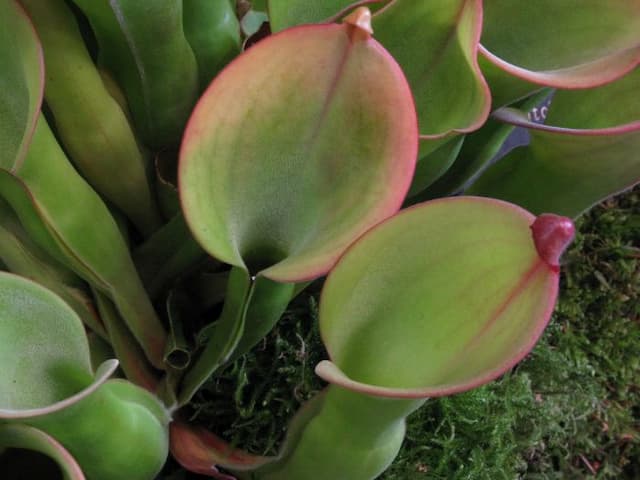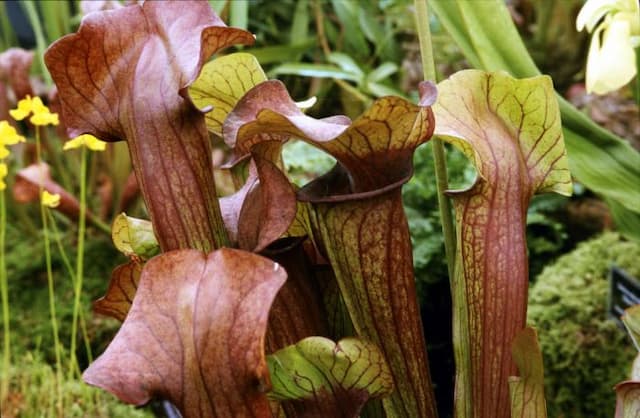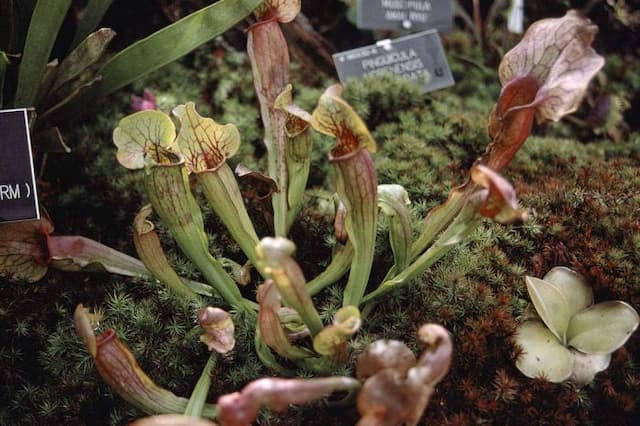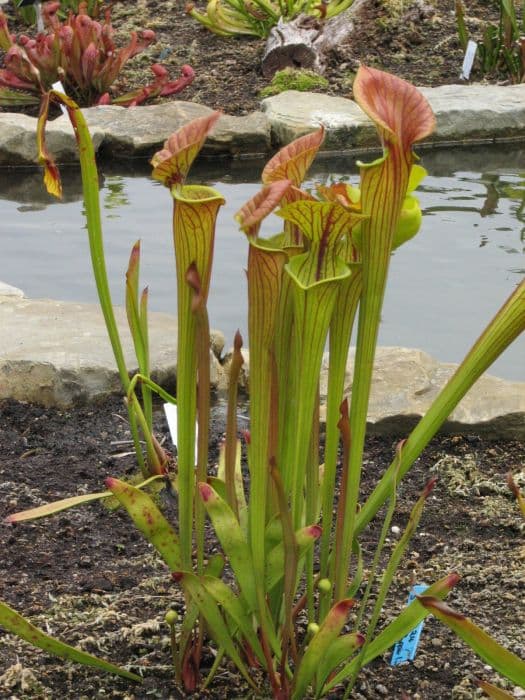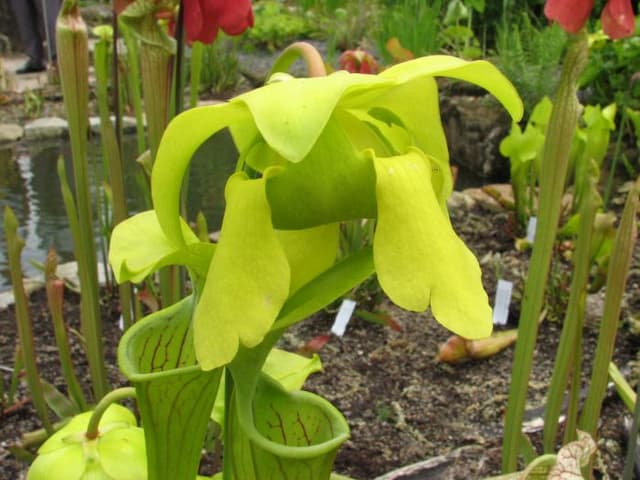Purple Pitcher Plant Sarracenia purpurea subsp. purpurea

ABOUT
The plant is commonly known as the purple pitcher plant due to its distinctive pitcher-shaped leaves, which are arranged in a rosette formation at the base. These pitchers are predominantly green with purplish-red veining, creating a marbled appearance, and they darken with age. The pitchers are not only colorful but also function as traps for insects, luring them in with nectar around the rim. The rim, known as the peristome, is typically undulating and can be more pronounced in color, often a deeper red or purple. The leaves of the plant are modified into these tubular pitchers, which are filled with a mixture of water and digestive enzymes. The inner surface of the pitchers is very slippery, preventing prey from escaping once they have fallen in. The pitchers also have a hood-like structure, known as the operculum, which helps prevent rainwater from diluting the digestive fluid inside. Above the ground-hugging pitchers, the purple pitcher plant produces flowers on a tall, leafless stalk that emerges from the center of the rosette. The flowers are quite showy and typically a deep red to purplish color. They have an umbrella-like appearance, with numerous petals hanging below a rounded, central structure. These flowers give off a sweet scent to attract pollinators. The overall appearance of the plant is quite striking with its unique pitcher-shaped leaves and vibrant colors, which can add an exotic touch to bog gardens or be a point of interest in collections of carnivorous plants.
About this plant
 Names
NamesSynonyms
Purple Pitcher Plant, Northern Pitcher Plant, Side-Saddle Flower, Huntsman's Cup, Indian Dipper.
Common names
Sarracenia purpurea var. purpurea, Sarracenia purpurea f. purpurea.
 Toxicity
ToxicityTo humans
The common name of Sarracenia purpurea subsp. purpurea is the Purple Pitcher Plant. This carnivorous plant is not considered toxic to humans. There is no widespread evidence or significant reports of poisoning in humans following ingestion of parts of the Purple Pitcher Plant. Therefore, consuming it is not expected to lead to serious health consequences based on current knowledge. However, as with any plant not generally recognized as food, individual allergies or sensitivities could potentially cause mild gastrointestinal upset or allergic reactions in susceptible individuals.
To pets
The common name of Sarracenia purpurea subsp. purpurea is the Purple Pitcher Plant. This plant is generally not known to be toxic to pets. There are no widely reported or well-documented cases of pet poisoning from consuming parts of the Purple Pitcher Plant. Pets are likely to experience little to no toxic effects if they ingest this plant. Despite this, it is always prudent to prevent pets from ingesting non-food plants as individual reactions can vary, and there may be a risk of gastrointestinal distress or other mild symptoms in sensitive animals.
 Characteristics
CharacteristicsLife cycle
Perennials
Foliage type
Evergreen
Color of leaves
Green
Flower color
Purple
Height
1-2 feet (30-60 cm)
Spread
1-2 feet (30-60 cm)
Plant type
Herb
Hardiness zones
3
Native area
North America
Benefits
 General Benefits
General Benefits- Ecological Role: Sarracenia purpurea subsp. purpurea, commonly known as the purple pitcher plant, serves an important role in the ecosystems it inhabits by providing a habitat for various invertebrate species.
- Insect Control: By trapping and digesting insects, the purple pitcher plant helps to naturally control pest populations.
- Ornamental Value: With its unique pitcher-shaped leaves and striking flowers, the purple pitcher plant is prized for its ornamental appeal in gardens and terrariums.
- Education and Research: This species is used in educational settings and research to study carnivorous plant biology, ecology, and evolution.
- Conservation Indicator: As a sensitive species, the purple pitcher plant can indicate the health of the wetland ecosystems where it lives.
 Medical Properties
Medical Properties- Traditional use by indigenous peoples as a remedy for smallpox.
- Historically used by Native Americans to treat various ailments such as rheumatism and fevers.
- Applied externally as a poultice for wounds and boils.
- Used in homeopathic practices for various indications, although clinical evidence is lacking.
 Air-purifying Qualities
Air-purifying QualitiesThis plant is not specifically known for air purifying qualities.
 Other Uses
Other Uses- Insect control: The Purple Pitcher Plant traps and digests insects, effectively reducing the pest population in a garden or greenhouse without the need for chemical pesticides.
- Ornamental uses: Due to its unique and exotic appearance, it is often used in ornamental gardening, adding an interesting aesthetic touch to flowerbeds, bog gardens, and water features.
- Photography subject: It's an attractive subject for nature photographers who are drawn to its distinctive shape and coloration, as well as its role in the ecosystem.
- Educational resource: The Purple Pitcher Plant is used in educational settings to teach about carnivorous plants, their mechanisms of nutrient acquisition, and their ecological roles.
- Scientific study: Researchers use Sarracenia purpurea subsp. purpurea to study evolutionary adaptations, plant-insect interactions, and the effects of nutrient-poor environments on plant growth.
- Botanical art: The striking appearance of the Purple Pitcher Plant has inspired botanical artists to create detailed drawings, paintings, and illustrations.
- Collector's item: Enthusiasts of carnivorous plants often collect various morphs and hybrids of the Purple Pitcher Plant, making it a prized element of private botanical collections.
- Water purification: Established naturally in waterlogged conditions, the plant may play a minor role in purifying the water by trapping and breaking down organic matter.
- Environmental indicator: Sarracenia purpurea subsp. purpurea can serve as an indicator species for the health of bog and wetland ecosystems where it naturally occurs.
- Composting aid: The dead leaves and undigested remains around the base of the Purple Pitcher Plant contribute to the composting process in boggy soil areas, enriching the substrate over time.
Interesting Facts
 Feng Shui
Feng ShuiThe Purple Pitcher Plant is not used in Feng Shui practice.
 Zodiac Sign Compitability
Zodiac Sign CompitabilityThe Purple Pitcher Plant is not used in astrology practice.
 Plant Symbolism
Plant Symbolism- Uniqueness: The Purple Pitcher Plant, with its distinctive pitcher-like leaves, represents the concept of uniqueness or standing out from the crowd, much like its unique adaptation to its environment.
- Adaptability: This plant's ability to thrive in nutrient-poor soils symbolizes adaptability and making the most out of difficult situations.
- Patience: The way the Purple Pitcher Plant slowly traps and digests insects can be seen as emblematic of patience and waiting for the right moment.
- Attraction and Deception: Its practice of attracting insects with nectar before trapping them can symbolize the dual concepts of attraction and deception.
 Water
WaterThe Purple Pitcher Plant should be kept consistently moist and prefers growing in wet, boggy conditions. Water the plant with about one to two gallons of distilled or rainwater per week during its growing season in spring and summer. The soil should never be allowed to dry out completely. In winter, reduce watering to maintain dampness without waterlogging the plant, providing about half a gallon every week or as needed to prevent dryness.
 Light
LightPurple Pitcher Plants thrive in full sunlight to partial shade. They should be placed in a spot where they can receive direct sunlight for several hours each day. The best location would be somewhere that offers a minimum of six hours of direct sun, while protecting them from the intense late afternoon sun which can sometimes be too harsh.
 Temperature
TemperaturePurple Pitcher Plants do best in temperatures that range from 70 to 90 degrees Fahrenheit during the day and should not drop below 20 degrees Fahrenheit at night. They can survive mild freezes, but prolonged exposure to temperatures below 20 degrees Fahrenheit can be damaging. The ideal growing conditions are warm, humid days and cooler nights.
 Pruning
PruningPruning the Purple Pitcher Plant mainly involves removing dead or damaged pitchers and flowers to encourage new growth. It is best to prune during early spring before the growing season starts or after the plant has flowered. Prune dead pitchers as needed throughout the year to maintain plant health.
 Cleaning
CleaningAs needed
 Soil
SoilThe Pitcher Plant prefers a mix of 50% peat moss and 50% perlite or sand for good drainage. The soil pH should be acidic, around 4.0 to 5.0.
 Repotting
RepottingThe Pitcher Plant should be repotted every 2 to 3 years to refresh the soil and accommodate growth.
 Humidity & Misting
Humidity & MistingPitcher Plants thrive in high humidity, generally above 60%, to maintain their pitcher's health and proper function.
 Suitable locations
Suitable locationsIndoor
Use bright, indirect light and maintain high humidity for indoor Pitcher Plants.
Outdoor
Place in full sun to partial shade and keep soil moist for outdoor Pitcher Plants.
Hardiness zone
3-9 USDA
 Life cycle
Life cycleThe common name for Sarracenia purpurea subsp. purpurea is the purple pitcher plant. Its life cycle begins as a dormant seed which, after exposure to cold temperatures through winter, germinates in the spring. The seedling then emerges and develops into a rosette of pitcher-shaped leaves specialized for trapping and digesting insects, drawing nutrients from them. Over the years, the plant continues to grow, forming a larger clump of pitchers with each growing season. In late spring to early summer, it produces a tall flower stalk topped with a singular, nodding flower, which once pollinated, develops into a capsule containing numerous seeds. The purple pitcher plant's life cycle completes when these seeds are dispersed, often by wind or water, to begin the next generation.
 Propogation
PropogationPropogation time
Spring-Early Summer
Propogation: The most popular method of propagating the Purple Pitcher Plant is through division, which is best done in early spring before the plant enters its active growing phase. To propagate by division, carefully remove the plant from its pot and gently separate the rhizomes, ensuring that each division has at least one growth point. Replant the divisions into pots filled with a suitable carnivorous plant soil mix, typically a blend of peat moss and perlite or sand. Water the newly potted plants thoroughly, using distilled or rainwater, and maintain high humidity around them as they establish. With proper care, the divisions will develop into new individual plants over the course of the growing season.
